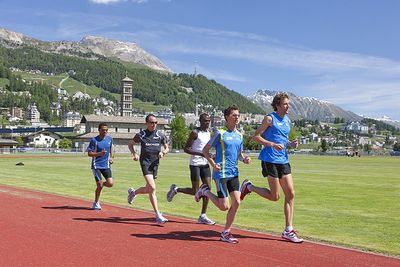Difference between revisions of "Altitude Training"
User:Fellrnr (User talk:Fellrnr | contribs) |
User:Fellrnr (User talk:Fellrnr | contribs) |
||
| (5 intermediate revisions by the same user not shown) | |||
| Line 1: | Line 1: | ||
[[File:AltitudeTraining.jpg|right|thumb|400px|Altitude training in the Swiss Olympic Training Base in the Alps]] | [[File:AltitudeTraining.jpg|right|thumb|400px|Altitude training in the Swiss Olympic Training Base in the Alps]] | ||
| − | Training at high altitude has been shown to improve endurance. And high-altitude there is less oxygen available, and this forces adaptations such as increased red blood count and improved muscle metabolism that help with endurance both at altitude and at sea level. Initial | + | Training at high altitude has been shown to improve endurance. And high-altitude there is less oxygen available, and this forces adaptations such as increased red blood count and improved [[Muscle|muscle]] metabolism that help with endurance both at altitude and at sea level. Initial [[Altitude Training Approaches]] involved living at a high altitude location for some time, and this approach is still used by many of the athletes. However, this is expensive and impractical for many people, so various altitude simulation approaches have been developed. Most of these approaches reduce the oxygen content of normal pressure air at low altitude. Altitude training can have a number of benefits, depending on the [[Altitude Training Approaches| Altitude Training Technique]] used: |
| + | * Increased number of red blood cells, which improves the oxygen carrying capacity of the blood and therefore [[VO2max|V̇O<sub>2</sub>max]]. | ||
| + | * Improved efficiency in oxygen usage (mitochondrial respiration). | ||
| + | * Greater resistance to free radicals through improved anti-oxidant defenses. | ||
| + | * Adaption in [[Breathing]] patterns at altitude. | ||
| + | * A shift from [[Protein]] to fat as an energy source. | ||
| + | ==Personal Experaince== | ||
| + | I have been using [[Intermittent Hypoxic Exposure]] based altitude training for some years, and I believe it has helped me be competitive. I've developed a [[DIY Altitude Training]] system to reduce the cost for other athletes, as well as some [[Hypoxic Timer| timing and analysis software]] that interfaces into a [[Pulse Oximeter]]. | ||
==See Also== | ==See Also== | ||
* [[Altitude Training Approaches]] | * [[Altitude Training Approaches]] | ||
* [[Comparison of Altitude Training Systems]] | * [[Comparison of Altitude Training Systems]] | ||
* [[AltoLab]] | * [[AltoLab]] | ||
| − | * [[Altitude Training | + | * [[The Science of Altitude Training]] |
* [[Book Review of Altitude Training and Athletic Performance]] | * [[Book Review of Altitude Training and Athletic Performance]] | ||
| − | * [[Intermittent Hypoxic Exposure]] and [[Intermittent Hypoxic Exposure | + | * [[Intermittent Hypoxic Exposure]] and [[The Science of Intermittent Hypoxic Exposure]] |
* [[Chronic Mountain Sickness]] | * [[Chronic Mountain Sickness]] | ||
* [[Viagra, Exercise and Altitude]] | * [[Viagra, Exercise and Altitude]] | ||
Latest revision as of 15:27, 29 July 2013
Training at high altitude has been shown to improve endurance. And high-altitude there is less oxygen available, and this forces adaptations such as increased red blood count and improved muscle metabolism that help with endurance both at altitude and at sea level. Initial Altitude Training Approaches involved living at a high altitude location for some time, and this approach is still used by many of the athletes. However, this is expensive and impractical for many people, so various altitude simulation approaches have been developed. Most of these approaches reduce the oxygen content of normal pressure air at low altitude. Altitude training can have a number of benefits, depending on the Altitude Training Technique used:
- Increased number of red blood cells, which improves the oxygen carrying capacity of the blood and therefore V̇O2max.
- Improved efficiency in oxygen usage (mitochondrial respiration).
- Greater resistance to free radicals through improved anti-oxidant defenses.
- Adaption in Breathing patterns at altitude.
- A shift from Protein to fat as an energy source.
1 Personal Experaince
I have been using Intermittent Hypoxic Exposure based altitude training for some years, and I believe it has helped me be competitive. I've developed a DIY Altitude Training system to reduce the cost for other athletes, as well as some timing and analysis software that interfaces into a Pulse Oximeter.
2 See Also
- Altitude Training Approaches
- Comparison of Altitude Training Systems
- AltoLab
- The Science of Altitude Training
- Book Review of Altitude Training and Athletic Performance
- Intermittent Hypoxic Exposure and The Science of Intermittent Hypoxic Exposure
- Chronic Mountain Sickness
- Viagra, Exercise and Altitude
